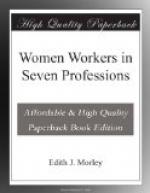Money Order Department to hand over all the simpler
duties to a new class of Assistant Women Clerks with
an eight-hour day and a wage of 18s. rising to 34s.
a week. The Association of Post Office Women
Clerks, the basis of which is “equal pay and
opportunities for women with men in the Civil Service,”
and which therefore necessarily stands for simplification
of the classes of employment, regarded the restriction
of a fresh grade of women to yet another water-tight
compartment at a low wage as in itself an evil.
But apart from this, they looked upon the scheme as
a deliberate evasion of the Hobhouse Committee’s
recommendations. So strong was the criticism levelled
at the new scheme, both by Members of Parliament and
the Press, that the Postmaster-General, Mr Herbert
Samuel, consented to refer the matter to the Select
Committee on the Post Office (known as the Holt Committee)[1],
which was appointed in the early part of 1912, and
he gave an undertaking that no more appointments to
the new grade should be made in the Money Order Department
until the Committee had reported, The value of this
concession was considerably lessened by its limited
application, and the fact that many Assistant Women
Clerks were subsequently appointed to the London Telephone
Service, clearly indicated the intention of the authorities
to proceed with the development of the scheme in a
Department which provided an easier field of operation
in the shape of new work and a new staff taken over
from the National Telephone Company.
In 1897 the class of Girl Clerks was created, to undertake
some of the simpler duties in the Savings Bank Department,
hitherto performed by Women Clerks. They were
subsequently introduced into the Money Order Department
and the Controller’s Office of the London Telephone
Service, and there are approximately 250 now employed.
They take the same examination as Women Clerks, but
at a lower age—sixteen to eighteen—and
are grouped apart for the purpose of marking.
Their hours of duty are seven daily, and their salary
L42, raising by L3 per annum, to L48. They are
in reality a probationary class, and become Women
Clerks automatically after two years’ service.
The introduction of this class was not considered
by the Department to be an administrative success,
as the obligation to make them Women Clerks in two
years prevented their being employed in sufficiently
large numbers to effect any appreciable economy.
The scheme for the introduction of the grade of Assistant
Woman Clerk involved the abolition of the Girl Clerk.
The Women Clerks are an analogous grade to the Male
Clerks of the Second Division who are common to the
whole Civil Service, and they do practically the same
class of work. The examinations for the two classes
are somewhat severe in character and are roughly comparable.[2]
There is, however, a wide disparity in the salaries
paid, as will be seen from the following comparison:—
SECOND DIVISION CLERKS.




